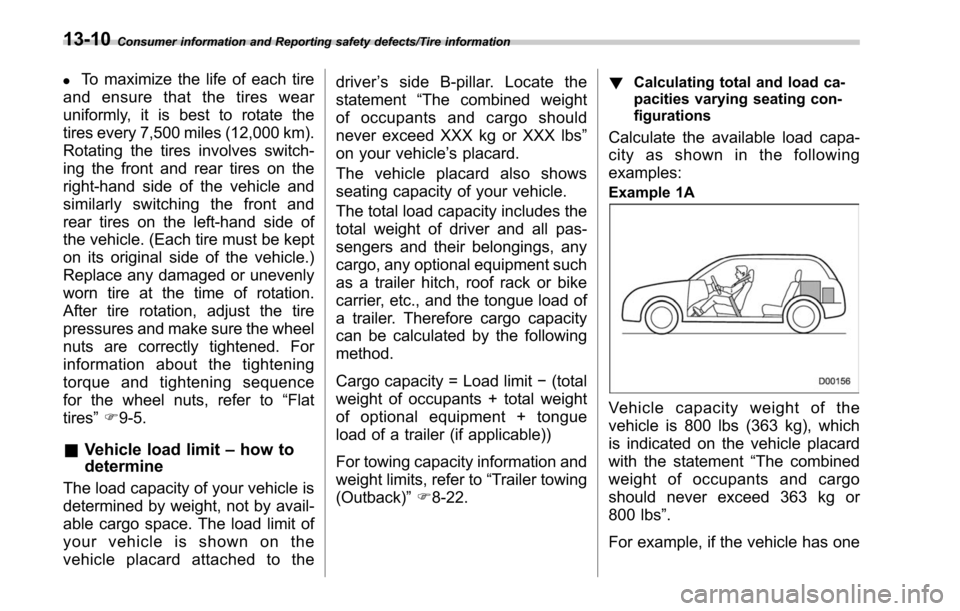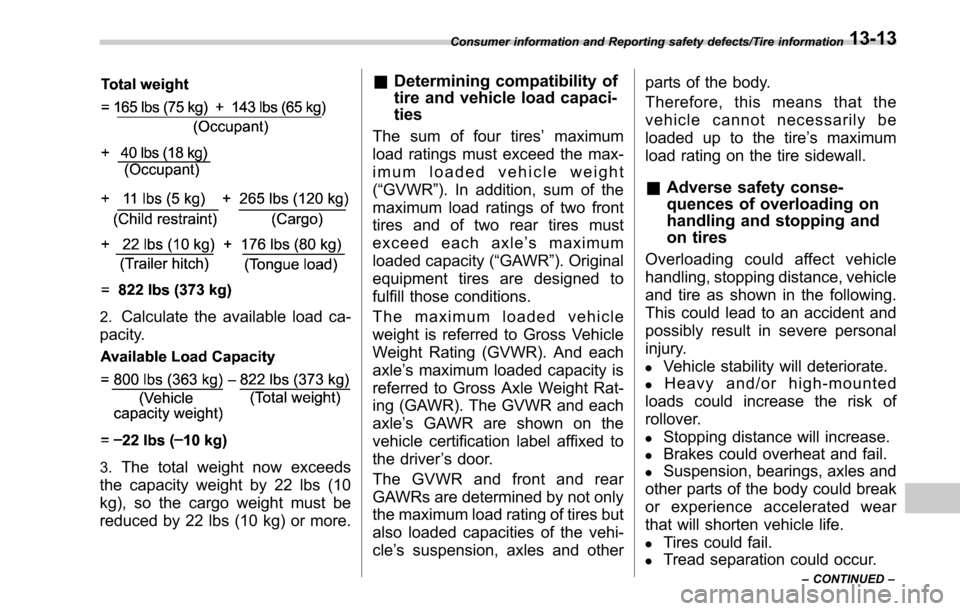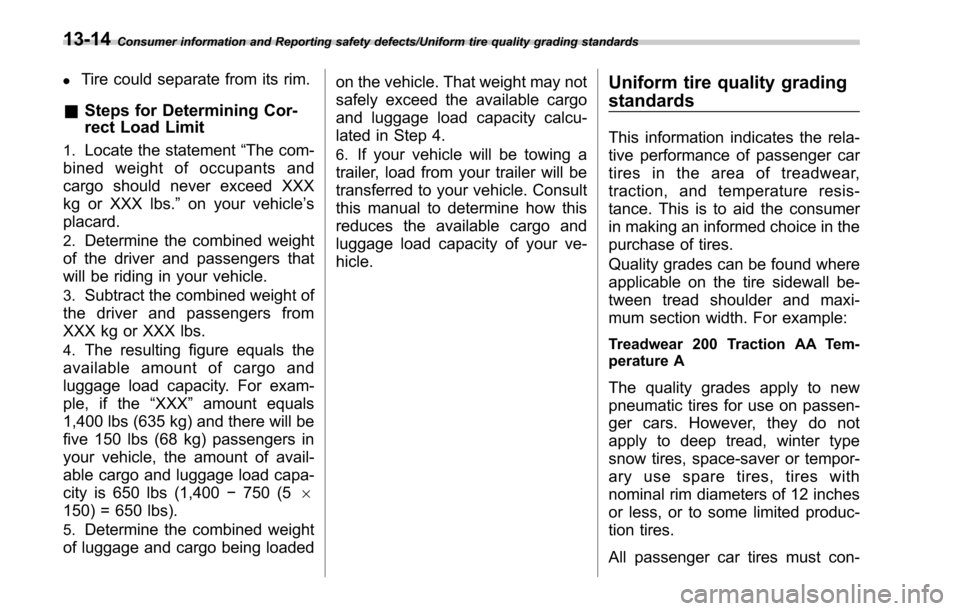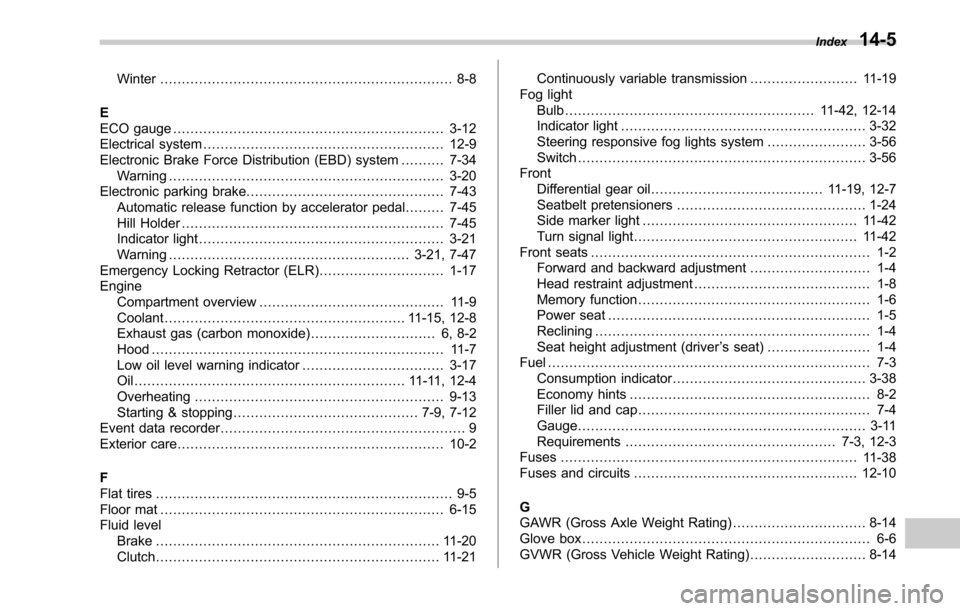2017 SUBARU LEGACY tires
[x] Cancel search: tiresPage 583 of 610

Consumer information and Reporting safety defects/Tire information
.To maximize the life of each tire
and ensure that the tires wear
uniformly, it is best to rotate the
tires every 7,500 miles (12,000 km).
Rotating the tires involves switch-
ing the front and rear tires on the
right-hand side of the vehicle and
similarly switching the front and
rear tires on the left-hand side of
the vehicle. (Each tire must be kept
on its original side of the vehicle.)
Replace any damaged or unevenly
worn tire at the time of rotation.
After tire rotation, adjust the tire
pressures and make sure the wheel
nuts are correctly tightened. For
information about the tightening
torque and tightening sequence
for the wheel nuts, refer to “Flat
tires ”F 9-5.
& Vehicle load limit –how to
determine
The load capacity of your vehicle is
determined by weight, not by avail-
able cargo space. The load limit of
your vehicle is shown on the
vehicle placard attached to the driver
’s side B-pillar. Locate the
statement “The combined weight
of occupants and cargo should
never exceed XXX kg or XXX lbs ”
on your vehicle ’s placard.
Thevehicleplacardalsoshows
seating capacity of your vehicle.
The total load capacity includes the
total weight of driver and all pas-
sengers and their belongings, any
cargo, any optional equipment such
as a trailer hitch, roof rack or bike
carrier, etc., and the tongue load of
a trailer. Therefore cargo capacity
can be calculated by the following
method.
Cargo capacity = Load limit −(total
weight of occupants + total weight
of optional equipment + tongue
load of a trailer (if applicable))
For towing capacity information and
weight limits, refer to “Trailer towing
(Outback) ”F 8-22.
! Calculating total and load ca-
pacities varying seating con-
figurations
Calculate the available load capa-
city as shown in the following
examples:
Example 1A
Vehicle capacity weight of the
vehicle is 800 lbs (363 kg), which
is indicated on the vehicle placard
with the statement “The combined
weight of occupants and cargo
should never exceed 363 kg or
800 lbs ”.
For example, if the vehicle has one
13-10
Page 586 of 610

2.Calculate the available load ca-
pacity.
3.The total weight now exceeds
the capacity weight by 22 lbs (10
kg), so the cargo weight must be
reduced by 22 lbs (10 kg) or more.
& Determining compatibility of
tire and vehicle load capaci-
ties
The sum of four tires ’maximum
load ratings must exceed the max-
imum loaded vehicle weight
( “ GVWR ”). In addition, sum of the
maximum load ratings of two front
tires and of two rear tires must
exceed each axle ’smaximum
loaded capacity ( “GAWR ”). Original
equipment tires are designed to
fulfill those conditions.
The maximum loaded vehicle
weight is referred to Gross Vehicle
Weight Rating (GVWR). And each
axle ’s maximum loaded capacity is
referred to Gross Axle Weight Rat-
ing (GAWR). The GVWR and each
axle ’s GAWR are shown on the
vehicle certification label affixed to
the driver ’s door.
The GVWR and front and rear
GAWRs are determined by not only
the maximum load rating of tires but
also loaded capacities of the vehi-
cle ’s suspension, axles and other parts of the body.
Therefore, this means that the
vehicle cannot necessarily be
loaded up to the tire
’s maximum
load rating on the tire sidewall.
& Adverse safety conse-
quences of overloading on
handling and stopping and
on tires
Overloading could affect vehicle
handling, stopping distance, vehicle
and tire as shown in the following.
This could lead to an accident and
possibly result in severe personal
injury.
.Vehicle stability will deteriorate.
.Heavy and/or high-mounted
loads could increase the risk of
rollover.
.Stopping distance will increase.
.Brakes could overheat and fail.
.Suspension, bearings, axles and
other parts of the body could break
or experience accelerated wear
that will shorten vehicle life.
.Tires could fail.
.Tread separation could occur.
Consumer information and Reporting safety defects/Tire information
–CONTINUED –13-13
Page 587 of 610

Consumer information and Reporting safety defects/Uniform tire quality grading standards
.Tire could separate from its rim.
&Steps for Determining Cor-
rect Load Limit
1.Locate the statement “The com-
bined weight of occupants and
cargo should never exceed XXX
kg or XXX lbs. ”on your vehicle ’s
placard.
2.Determine the combined weight
of the driver and passengers that
will be riding in your vehicle.
3.Subtract the combined weight of
the driver and passengers from
XXX kg or XXX lbs.
4.The resulting figure equals the
available amount of cargo and
luggage load capacity. For exam-
ple, if the “XXX ”amount equals
1,400 lbs (635 kg) and there will be
five 150 lbs (68 kg) passengers in
your vehicle, the amount of avail-
able cargo and luggage load capa-
city is 650 lbs (1,400 −750 (5 6
150) = 650 lbs).
5.Determine the combined weight
of luggage and cargo being loaded on the vehicle. That weight may not
safely exceed the available cargo
and luggage load capacity calcu-
lated in Step 4.
6.If your vehicle will be towing a
trailer, load from your trailer will be
transferred to your vehicle. Consult
this manual to determine how this
reduces the available cargo and
luggage load capacity of your ve-
hicle.
Uniform tire quality grading
standards
This information indicates the rela-
tive performance of passenger car
tires in the area of treadwear,
traction, and temperature resis-
tance. This is to aid the consumer
in making an informed choice in the
purchase of tires.
Quality grades can be found where
applicable on the tire sidewall be-
tween tread shoulder and maxi-
mum section width. For example:
Treadwear 200 Traction AA Tem-
perature A
The quality grades apply to new
pneumatic tires for use on passen-
ger cars. However, they do not
apply to deep tread, winter type
snow tires, space-saver or tempor-
ary use spare tires, tires with
nominal rim diameters of 12 inches
or less, or to some limited produc-
tion tires.
All passenger car tires must con-
13-14
Page 588 of 610

form to Federal Safety Require-
ments in addition to these grades.
&Treadwear
The treadwear grade is a compara-
tive rating based on the wear rate of
the tire when tested under con-
trolled conditions on a specified
government test course.
For example, a tire graded 150
would wear one and one-half (1-
1/2) times as well on the govern-
ment course as a tire graded 100.
The relative performance of tires
depends upon the actual conditions
of their use, however, and may
depart significantly from the norm
due to variations in driving habits,
service practices and differences in
road characteristics and climate.
&Traction AA, A, B, C
The traction grades, from highest to
lowest, are AA, A, B and C. Those
grades represent the tire ’s ability to
stop on wet pavement as measured
under controlled conditions on spe- cified government test surfaces of
asphalt and concrete. A tire marked
C may have poor traction perfor-
mance.
WARNING
The traction grade assigned to
this tire is based on straight-
ahead braking traction tests,
and does not include accel-
eration, cornering, hydroplan-
ing, or peak traction charac-
teristics.
&
Temperature A, B, C
The temperature grades are A (the
highest), B, and C, representing the
tire ’s resistance to the generation of
heat and its ability to dissipate heat
when tested under controlled con-
ditions on a specified indoor labora-
tory test wheel. Sustained high
temperature can cause the material
of the tire to degenerate and reduce
tire life, and excessive temperature
can lead to sudden tire failure. The grade C corresponds to a level of
performance which all passenger
car tires must meet under the
Federal Motor Vehicle Safety Stan-
dard No. 109. Grades B and A
represent higher levels of perfor-
mance on the laboratory test wheel
than the minimum required by law.
WARNING
The temperature grade for this
tire is established for a tire
that is properly inflated and
not overloaded. Excessive
speed, underinflation, or ex-
cessive loading, either sepa-
rately or in combination, can
cause heat buildup and possi-
ble tire failure.
Consumer information and Reporting safety defects/Uniform tire quality grading standards13-15
Page 594 of 610

Winter.................................................................... 8-8
E
ECO gauge ............................................................... 3-12
Electrical system ........................................................ 12-9
Electronic Brake Force Distribution (EBD) system .......... 7-34
Warning ................................................................ 3-20
Electronic parking brake. ............................................. 7-43
Automatic release function by accelerator pedal ......... 7-45
Hill Holder ............................................................. 7-45
Indicator light ......................................................... 3-21
Warning ........................................................ 3-21, 7-47
Emergency Locking Retractor (ELR) ............................. 1-17
Engine Compartment overview ........................................... 11-9
Coolant ........................................................ 11-15, 12-8
Exhaust gas (carbon monoxide) ............................. 6, 8-2
Hood .................................................................... 11-7
Low oil level warning indicator ................................. 3-17
Oil............................................................... 11-11, 12-4
Overheating .......................................................... 9-13
Starting & stopping ........................................... 7-9, 7-12
Event data recorder ......................................................... 9
Exterior care .............................................................. 10-2
F
Flat tires ..................................................................... 9-5
Floor mat .................................................................. 6-15
Fluid level Brake .................................................................. 11-20
Clutch .................................................................. 11-21 Continuously variable transmission
......................... 11-19
Fog light Bulb .......................................................... 11-42, 12-14
Indicator light ......................................................... 3-32
Steering responsive fog lights system ....................... 3-56
Switch ................................................................... 3-56
Front Differential gear oil ........................................ 11-19, 12-7
Seatbelt pretensioners ............................................ 1-24
Side marker light .................................................. 11-42
Turn signal light .................................................... 11-42
Front seats ................................................................. 1-2
Forward and backward adjustment ............................ 1-4
Head restraint adjustment ......................................... 1-8
Memory function ...................................................... 1-6
Power seat ............................................................. 1-5
Reclining ................................................................ 1-4
Seat height adjustment (driver ’s seat) ........................ 1-4
Fuel ........................................................................\
... 7-3
Consumption indicator ............................................. 3-38
Economy hints ........................................................ 8-2
Filler lid and cap ...................................................... 7-4
Gauge ................................................................... 3-11
Requirements ................................................. 7-3, 12-3
Fuses .....................................................................
11-38
Fuses and circuits .................................................... 12-10
G
GAWR (Gross Axle Weight Rating) .. ............................. 8-14
Glove box ................................................................... 6-6
GVWR (Gross Vehicle Weight Rating) ........................... 8-14
Index14-5
Page 599 of 610

14-10Index
Heater.................................................................... 1-9
Height adjustment .................................................... 1-4
Memory function ...................................................... 1-6
Power ..................................................................... 1-5
Rear ..................................................................... 1-11
Seatbelt ................................................................. 4, 1-16
Fastening .............................................................. 1-17
Maintenance .......................................................... 1-24
Pretensioners ........................................................ 1-24
Safety tips ............................................................. 1-16
Warning light and chime ......................................... 3-13
Security Alarm system ........................................................ 2-28
Immobilizer. ............................................................. 2-4
Indicator light ......................................................... 3-30
Shock sensors ....................................................... 2-33
Select lever Position indicator ................................................... 3-31
Shift lock function ................................................... 7-28
Shock sensors ........................................................... 2-33
Shopping bag hook .................................................... 6-13
Snow tires ........................................................ 8-11, 11-25
Snowy and icy roads .................................................. 8-10
Spark plugs ...................................................... 11-18, 12-9
Specifications ............................................................ 12-2
Speedometer ............................................................... 3-9
SRS airbag (Supplemental Restraint System airbag) ... 4, 1-41
SRS airbag system Monitors. ............................................................... 1-68
Servicing ............................................................... 1-69
Warning light ......................................................... 3-15 Starting & stopping engine
.................................... 7-9, 7-12
State emission testing (U.S. only) .................................. 7-7
Steering responsive fog lights system ... ........................ 3-56
OFF indicator ......................................................... 3-32
Steering switches for audio .......................................... 5-63
Steering wheel Lock ............................................................. 7-11, 7-14
Power ................................................................... 7-31
Tilt/telescopic ......................................................... 3-82
Stop light ................................................................. 12-15
Storage compartment ................................................... 6-6
Sun shade ................................................................. 2-50
Sun visors .................................................................. 6-4
Supplemental Restraint System airbag (SRS) ................ 1-41
Synthetic leather upholstery ......................................... 10-6
T
Tachometer ................................................................ 3-10
Temperature gauge ..................................................... 3-12
Temperature warning light AT OIL TEMP ......................................................... 3-17
Temporary spare tire .................................................... 9-2
Tether (child restraint system) .............................. 1-36, 1-39
Tie-down hooks .......................................................... 9-14
Tire................................................................. 11-25, 12-9 Chains ..................................................................
8-12
Inspection ............................................................ 11-27
Pressures and wear .............................................. 11-27
Replacement. ....................................................... 11-30
Rotation .............................................................. 11-30
Size and pressure .................................................. 12-9
Page 600 of 610

Types.................................................................. 11-25
Tire pressure monitoring system (TPMS). .... 7-41, 9-10, 11-25
Warning light ......................................................... 3-17
Tires and wheels. ...................................................... 11-25
Tools ........................................................................\
.. 9-3
Top tether anchorages ........................................ 1-36, 1-39
Towing ...................................................................... 9-13
All wheels on the ground ........................................ 9-17
Flat-bed truck ........................................................ 9-16
Hooks ................................................................... 9-14
Weight.................................................................. 8-22
Trailer Connecting ............................................................ 8-20
Hitch (Outback) .............................................. 8-19, 8-26
Towing .................................................................. 8-22
Towing tips ............................................................ 8-27
Trip meter ................................................................. 3-10
Trunk lid ........................................................... 2-38, 9-19
Release handle ..................................................... 2-39
Trunk light ................................................................ 11-49
Turn signal Indicator lights ....................................................... 3-31
Lever .................................................................... 3-54
U
Under-floor storage compartment ................................. 6-20
V
Valet mode ................................................................ 2-33
Vanity mirror ................................................................ 6-5 Vehicle
Capacity weight ...................................................... 8-14
Identification ........................................................ 12-18
Symbols .................................................................... 4
Vehicle Dynamics Control OFF indicator light .................................................. 3-25
OFF switch ............................................................ 7-37
Operation indicator light ........................................... 3-24
System .................................................................. 7-35
Warning light .......................................................... 3-24
Ventilator .................................................................... 4-2
Voice command operation ........................................... 5-81
W
Warning and indicator lights ......................................... 3-13
Warning chimes Keyless access with push-button start system .... ........ 3-25
Seatbelt. ................................................................ 3-13
Warning light ABS...................................................................... 3-19
Access key ............................................................ 3-25
All-Wheel Drive ...................................................... 3-23
AT OIL TEMP ......................................................... 3-17
Automatic headlight beam leveler ............................. 3-32
Brake system ......................................................... 3-19
BSD/RCTA ............................................................ 3-32
Charge .................................................................. 3-16
CHECK ENGINE .................................................... 3-16
Engine low oil level ................................................. 3-17
High beam assist .................................................... 3-31
Keyless
access with push-button start system .... ........ 3-25
Index14-11
Page 601 of 610

14-12Index
Low fuel................................................................ 3-22
Low tire pressure ................................................... 3-17
Oil pressure .......................................................... 3-16
Power steering ...................................................... 3-23
Seatbelt ................................................................ 3-13
SRS airbag system ................................................ 3-15
Vehicle Dynamics Control ....................................... 3-24
Windshield washer fluid .......................................... 3-23
Warning volume
BSD/RCTA ............................................................ 3-45
EyeSight system .................................................... 3-44
Warranties ..................................................................... 1
Warranties and maintenance ....................................... 8-22
Washing ................................................................... 10-2
Waxing and polishing ................................................. 10-3
Wear indicators ......................................................... 11-29
Welcome lighting function ........................................... 3-48
Wheel Aluminum ............................................................. 11-32
Balance ............................................................... 11-29
Nut tightening torque .............................................. 12-9
Replacement ........................................................ 11-31
Windows ................................................................... 2-34
Windshield Washer fluid ......................................................... 11-32
Wiper and washer switches ..................................... 3-59
Wiper blades ........................................................ 11-34
Wiper deicer .......................................................... 3-61
Winter
Driving .................................................................... 8-8
Tires ............................................................ 8-11, 11-25 Wiper and washer
...................................................... 3-57
Wiper deicer .............................................................. 3-61
X
X-mode ..................................................................... 7-38
Indicator ................................................................ 3-32